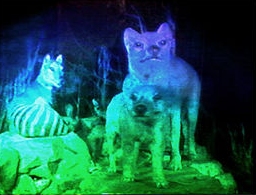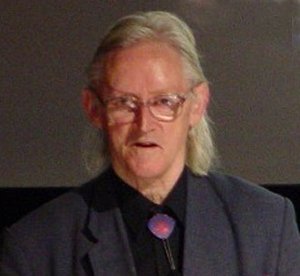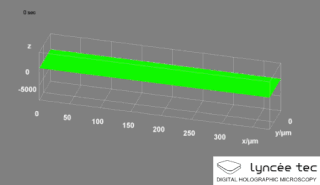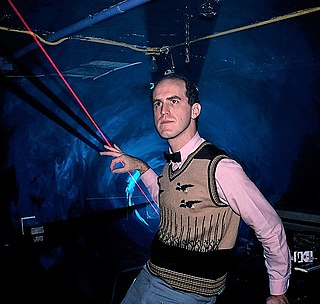
Holography is a technique that enables a wavefront to be recorded and later reconstructed. It is best known as a method of generating three-dimensional images, and has a wide range of other uses, including data storage, microscopy, and interferometry. In principle, it is possible to make a hologram for any type of wave.

The Holographic Versatile Disc (HVD) is an optical disc technology that was expected to store up to several terabytes of data on an optical disc 10 cm or 12 cm in diameter. Its development commenced in April 2004, but it never arrived due to lack of funding. The company responsible for HVD went bankrupt in 2010.

Holographic data storage is a potential technology in the area of high-capacity data storage. While magnetic and optical data storage devices rely on individual bits being stored as distinct magnetic or optical changes on the surface of the recording medium, holographic data storage records information throughout the volume of the medium and is capable of recording multiple images in the same area utilizing light at different angles.

The rainbow hologram is a type of hologram that was invented in 1968 by Dr. Stephen A. Benton at Polaroid Corporation. Rainbow holograms are designed to be viewed under white light illumination, rather than laser light which was required before this. The rainbow holography recording process uses a horizontal slit to eliminate vertical parallax in the output image, greatly reducing spectral blur while preserving three-dimensionality for most observers. A viewer moving up or down in front of a rainbow hologram sees changing spectral colors rather than different vertical perspectives. Because perspective effects are reproduced along one axis only, the subject will appear variously stretched or squashed when the hologram is not viewed at an optimum distance; this distortion may go unnoticed when there is not much depth, but can be severe when the distance of the subject from the plane of the hologram is very substantial. Stereopsis and horizontal motion parallax, two relatively powerful cues to depth, are preserved.
Lloyd Cross is an American physicist and holographer.
Holographic interferometry (HI) is a technique which enables the measurements of static and dynamic displacements of objects with optically rough surfaces at optical interferometric precision. These measurements can be applied to stress, strain and vibration analysis, as well as to non-destructive testing and radiation dosimetry. It can also be used to detect optical path length variations in transparent media, which enables, for example, fluid flow to be visualised and analyzed. It can also be used to generate contours representing the form of the surface.

Stephen Anthony Benton was the inventor of the rainbow hologram and a pioneer in medical imaging and fine arts holography. Benton held 14 patents in optical physics and photography, and taught media arts and sciences at Massachusetts Institute of Technology (MIT). He was the E. Rudge ('48) and Nancy Allen Professor of Media & Sciences, and the Director for Center for Advanced Visual Studies (CAVS) at MIT.
Volume holograms are holograms where the thickness of the recording material is much larger than the light wavelength used for recording. In this case diffraction of light from the hologram is possible only as Bragg diffraction, i.e., the light has to have the right wavelength (color) and the wave must have the right shape. Volume holograms are also called thick holograms or Bragg holograms.

Nicholas (Nick) John Phillips was an English physicist, notable for the development of photochemical processing techniques for the colour hologram. Holograms typically used to have low signal-to-noise ratios, and Phillips is credited as the pioneer of silver halide holographic processing techniques for producing high-quality reflection holograms.
A holographic display is a type of 3D display that utilizes light diffraction to display a three-dimensional image to the viewer. Holographic displays are distinguished from other forms of 3D displays in that they do not require the viewer to wear any special glasses or use external equipment to be able to see the image, and do not cause the vergence-accommodation conflict.

Digital holographic microscopy (DHM) is digital holography applied to microscopy. Digital holographic microscopy distinguishes itself from other microscopy methods by not recording the projected image of the object. Instead, the light wave front information originating from the object is digitally recorded as a hologram, from which a computer calculates the object image by using a numerical reconstruction algorithm. The image forming lens in traditional microscopy is thus replaced by a computer algorithm. Other closely related microscopy methods to digital holographic microscopy are interferometric microscopy, optical coherence tomography and diffraction phase microscopy. Common to all methods is the use of a reference wave front to obtain amplitude (intensity) and phase information. The information is recorded on a digital image sensor or by a photodetector from which an image of the object is created (reconstructed) by a computer. In traditional microscopy, which do not use a reference wave front, only intensity information is recorded and essential information about the object is lost.
Specular holography is a technique for making three dimensional imagery by controlling the motion of specular glints on a two-dimensional surface. The image is made of many specularities and has the appearance of a 3D surface-stippling made of dots of light. Unlike conventional wavefront holograms, specular holograms do not depend on wave optics, photographic media, or lasers.
Specialized Enterprise Holography Ltd. (SE Holography) is a company that specializes in production of holograms and holographic security elements. Holography, a member-company of the EDAPS Consortium, is among the founders of the security printing industry in Ukraine. Established in 2000 with the support of the International Centre the Institute of Applied Optics on behalf of the National Academy of Sciences of Ukraine. Holography Ltd. is a member of the International Hologram Manufacturers Association (IHMA), a member of the International Society for Optical Engineering (SPIE) and a member of the Counterfeiting Intelligence Bureau at the International Chamber of Commerce of Ukraine.

Yves Gentet is a French engineer and artist, known for the invention of a creative method of holograms in colour Ultimate and a 3D holographic printer Chimera.

A holographic weapon sight or holographic diffraction sight is a non-magnifying gunsight that allows the user to look through a glass optical window and see a holographic reticle image superimposed at a distance on the field of view. The hologram of the reticle is built into the window and is illuminated by a laser diode.
Wenyon & Gamble is the name used by the art team of Susan Gamble and Michael Wenyon.

Jason Sapan, also known as Dr. Laser is a holographer and actor who is the founder of Holographic Studios, the world's oldest gallery of holography, located in the borough of Manhattan in New York City. He is one of the pioneers of holography, and has also worked as an educator, recording engineer, artist, blogger, and actor. He has created portrait holograms of Andy Warhol, President Bill Clinton, Isaac Asimov, NYC Mayor Ed Koch, Prime Minister Edward Heath, Pierre Cardin, Sally Jessy Raphael, John Kenneth Galbraith, Phyllis Diller, Billy Idol, The Smothers Brothers, Phil Donahue, and John Cage. His corporate clientele include commissions for Mitsubishi, AT&T, Tag Heuer, Goodyear, IBM and NYU Medical Center.
Margaret Benyon,, was a British artist. Trained as a painter, she was one of the first artists to use holography as a medium and had her first solo show of holograms in 1969. She was appointed to the Order of the British Empire in 2000 for her service to art and has been called "the mother of British holography".

Matthew Schreiber is an American artist who is known for his work in holography and for his large scale laser light sculptures. Matthew Schreiber produces work in a wide variety of mediums, including drawing, performance, sculpture, video, and light. Recurring subjects within Schreiber's work center on novelty, the occult, and spectacle by using tools of physics, technology and perception. He has exhibited his work internationally, and most recently at large music festivals, an example of which can be found in his 2018 installation at Dark MOFO in Tasmania, in which Schreiber created a massive laser-light installation that completely immersed viewers.
Optical holography is a technique which enables an optical wavefront to be recorded and later re-constructed. Holography is best known as a method of generating three-dimensional images but it also has a wide range of other applications.













